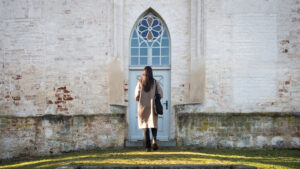In The Book of Common Prayer: A Biography, Alan Jacobs has produced a useful overview of the Anglo-Catholic approach to Anglican liturgy and the history of its prayer books. The professor of humanities at Baylor University endorses without qualification the fundamental assertion that the prayer books, rather than the 39 Articles of Religion, define and disseminate Anglican doctrine: “There had perhaps never been a church to which the motto lex orandi, lex credendi—the rule of prayer is the rule of belief—has been more applicable than the Church of England” (122). While noting with respect that today’s leading authorities on Cranmer think the archbishop planned to revise his traditionalist 1549 Book of Common Prayer in a substantially more Protestant direction, Jacobs considers this conclusion “plausible but by no means certain” and does his best to argue to the contrary (50, 209–210). That Cranmer was satisfied with the 1549 Book of Common Prayer as his liturgical masterpiece, “striking a proper balance between traditionalism and reform” (51), has long been a key tenet of Anglo-Catholic liturgical scholarship.
On the other hand, the Anglican evangelical tradition is mentioned only in passing, and then only from the negative viewpoint of the Oxford movement (127). No effort is made to explore 19th century evangelical vitality and their use of the prayer book—for example, Charles Simeon’s lectures Excellency in Liturgy and his deep suspicion of any ministry not rooted in the Book of Common Prayer. However, Jacobs does describe the work of F. D. Maurice, whose call for church unity—based not on doctrine but on the mystery of Eucharistic fellowship—is a key tenet of contemporary revisionist Anglo-Catholic scholarship. The 20th century follows the same pattern. The appreciation for the prayer book tradition by such vastly influential Anglican evangelical giants as John Stott and J. I. Packer is passed over in silence. Of course, in North America, as opposed to the worldwide Anglican Communion, Stott and Packer are more widely admired amongst non-Anglican audiences.
Sensitive, Admirable Account
Given the perimeters of his perspective and the brief nature of an introduction, Jacobs provides in many ways an admirable account. He’s written a concise, compelling narrative that reaches from 16th century England to the current global Anglican community. At times he shows remarkable sensitivity to the subject matter for a non-specialist. He rightly points out the counterintuitive truth that pre-Reformation English worship was mostly individual meditation, whereas the heart of Cranmer’s liturgy was the experience of corporate prayer (18–19). As background to Cranmer’s evening prayers, Jacobs helpfully elucidates the serious anxiety that nighttime created in a culture without abundant electric light (33–34). In addition, Jacobs highlights Cranmer’s often overlooked contribution to the English wedding service, adding references to companionship as a reason for marriage and “to love and to cherish” to the vows (40–41). Jacobs even describes how the centuries-long mandatory use of the Book of Common Prayer in British institutions shaped, for better or worse, the religious experience of countless generations.
Lapses in Execution
At many other points, however, the thinness of Jacobs’s learning in the field is evident. For example, Cranmer was associated with Jesus College, Cambridge, not Jesus College, Oxford (39). King Henry’s reform program was not erratic, but principled Erasmian humanism (11–12). Cranmer first commissioned the contributions to the Book of Homilies in 1542, not 1547 (17). He likely wrote the first and certainly the third, fourth, and fifth homilies, not the first four (15–16). The Order of the Communion was an English addendum to the Sarum Latin Mass, not a replacement (17). Cranmer’s prayer books were primarily a missionary means to convert the hearts of English people and only secondarily an “instrument of social and political control” (7). The 1552 Book of Common Prayer introduced compulsory attendance at Sunday worship, not the 1559 (206). Cranmer’s Communion services had only three readings from Scripture: Introductory Psalm, Epistle, and Gospel in 1549; Ten Commandments, Epistle, and Gospel in 1552—not four (Old Testament, Psalm, Epistle, and Gospel) (27). Cranmer wasn’t a mere memorialist, but a parallelist—that is, at the same time a faithful Christian received the bread and wine, the Holy Spirit went freshly and directly into that person’s soul to strengthen his presence there (166). Richard Hooker doesn’t “plainly” affirm something different from Cranmer, that “Christ is truly present in the Eucharistic elements” (166). Rather, Hooker clearly writes: “The real presence of Christ’s most blessed body and blood is not therefore to be sought for in the sacrament, but in the worthy receiver of the sacrament . . . only in the very heart and soul of him which receiveth” (Laws, V.67.6). Moreover, Hooker’s “theology of church order is, to an often surprising degree, pragmatic” (219) only if one fails to appreciate that the English reformers saw ecclesiology as something indifferent that needed to be adapted to local circumstances to ensure the effective proclamation of the gospel. The notion that liturgies also needed to be adapted to national cultural contexts was affirmed explicitly not only by Hooker, but also by Cranmer in the Articles of Religion (122). The number of Articles of Religion were only firmly set at 39 in 1571, not 1563 (92). The Millenary Petition of 1603 didn’t ask for the term “altar” to be removed from the prayer book, since it had already been removed in 1552 (69).

The Book of Common Prayer: A Biography
Alan Jacobs
Despite such notable lapses in execution, the greatest limitation of Jacobs’s narrative is the inability of his Anglo-Catholic perspective to appreciate the spirituality of Cranmer’s prayer books on their own terms. Jacobs recognizes the importance of Scripture for Cranmer’s liturgy, but not the double reason as to why. First, God’s Word, not a sacred priesthood, was the divine instrument through which people encountered the Holy Spirit. Second, the Bible alone presented the authoritative message of salvation by grace alone through faith alone which the Spirit wrote on people’s hearts and by which he transformed their lives. For Cranmer only divine gracious love—constantly communicated by the Spirit in the regular repetition of Scripture’s promises through Word and Sacrament—could inspire grateful human love, drawing believers toward God, their fellow human beings, and the lifelong pursuit of godliness. In short, the heart of Cranmer’s liturgies is moving human affections to serve God and neighbor by the power of the gospel.
Biblical, Evangelical Liturgy
Failing to appreciate the pulse of Cranmer’s liturgical work, Jacobs accepts the decline of its influence on modern Anglican liturgies. After all, for Anglo-Catholic liturgical scholarship it’s self-evident that following the ancient shape of Eucharistic action is best. Yet, the Reformation Anglicanism of Cranmer and Hooker actually points in a different direction entirely—that liturgies must constantly be contextualized to local contemporary culture to ensure an effective proclamation of the gospel. While many fleeing the aridness of biblical fundamentalism do seem to hop right over Cranmer and unquestioningly embrace a liturgical fundamentalism rooted only a few centuries later, perhaps that is not the best missional response for postmodern North America.
At its heart, Anglo-Catholic liturgical scholarship emphasizes what we do in cooperation with God’s assistance to become godly like him. Indeed, liturgy is seen as “the work of the people.” Yet in an era burned out from a message of being saved by grace but sustained by sweat, where those under 30 associate church with feeling pressure to be good enough, maybe a biblical, evangelical liturgy derived from Cranmer’s—one designed to emphasize what God has done, is doing, and will do for you and your community—is the more effective way forward. If the Reformers are right, it’ll only be because such a liturgy more closely reflects and more clearly imparts the true nature of the gospel.
Editors’ note (Sept. 17, 2015): Following a response from Alan Jacobs, Ashley Null offered to amend his review to clarify his points. While Jacobs explicitly disavows allegiance to Anglo-Catholicism, Null argues that Jacobs nevertheless depends on its presuppositions and scholarship.





























